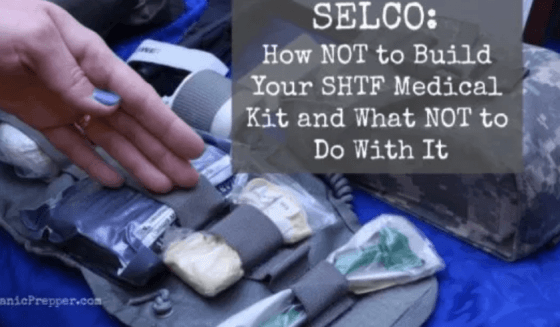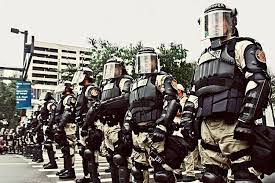This article was originally published by Selco at The Organic Prepper.

The medical field is one of my favorite fields of prepping, not only because it is my “field of work” for many years but also because it is very often misunderstood in prepping.
There are many reasons for that, one of the reasons is the fact that there are many other “cooler” topics for prepping. As a result, medical preparedness gets researched very superficial, and people prepare for it in a way that most of them want just to mark that as done and move on to other topics.
So as a foundation in medical prepping for SHTF think about a few things, for a start only.
“Help is on the way”
You know that sentence from the movies, books, documentaries and similar: “help is on the way?”
So you just need to “plug the hole”, keep the head of the wounded up, put wet tissue on his forehead or something similar until chopper for evacuation arrives, or paramedic unit or whatever.
Well, it will not work like that if the SHTF.
People often prepare for SHTF by storing weapons and ammo like they are expecting a full zombie apocalypse but at the same time, their first aid kits look like they are ordered them from China for 5.99 USD.
So you are expecting it is gonna be so bad that you need several different types of weapon and loads of ammo but you do not expect you are gonna have a medical emergency not more complicated than a blister?
Think again!
If you preparing for bad stuff, then expect the bad stuff that comes with it.
If you preparing for a complete absence of the system why does your first aid kit cover (barely) only the time up to the moment when medical help arrives – medical help that will absolutely not exist in a full-scale SHTF event?
In a real SHTF event, YOU probably gonna be all the help available, both immediate and prolonged, with stuff that you have prepped and with the knowledge that you have, so choose what to have and how much to learn.
What is cool vs. what is needed
Next step should be just like with most preps, choosing what is cool or choosing what is really needed.
If you have the resources to cover both, sure why not, but keep in mind that “what is needed” comes before “what is cool”. And what is needed MORE comes even before that.
Here is one example.
You attended a trauma care course given by ex-combat medic.
It is a cool and good course. You’ll learn how to manage bleeding and trauma while under pressure. Instructors are gonna simulate pressure by loud and unexpected noises while you are trying to treat someone with a gunshot wound, maybe instructors will fire shots (blanks) to simulate combat or explosions, or flashlights at you while you are treating the patient, etc.
As I said it is good and cool course. I have been on courses like that, both as a combat medic instructor and a student.
But mostly instructors failed to acknowledge one big thing there: They are instructing you in the knowledge that they have based on their work and experience.
That means treating injured as a professional and as part of a big and powerful system (in this case, the whole army).
So there is system (chopper, ambulance or whatever) to pick wounded after your short treatment, and there are resources no matter how much you need (IVs, bandages, gauzes…) because the system is there.
So, as a result, you are training and learning to use medical knowledge, not in SHTF, but you are training to use it in normal times.
Again, it is good knowledge, and valuable, it can be used today in normal times, and in SHTF, but it is only a small (and “cool” ) part of it.
But you are preparing for a time where there is no system (because SHTF) you need first to learn different stuff (too)
Another example would be that you need to learn how to disinfect your home or latrine, or to learn how to treat a prolonged wound, wound that is infected, or to recognize and treat pneumonia.
So, think a bit outside of that “cool” box.
A good start is to prepare for stuff that you are expecting to see when SHTF.
Do you really expect you are only gonna treat gunshot wounds (until help arrives) or do you think it is gonna be much more about hygiene, infection, antibiotics, bad food, and water-induced conditions and similar?
“Buy this!”
“Buy this because it will save your life” does not mean too much until you research it and test it.
I think around 70 % of students coming to my courses with first aid kits that have stuff completely unopened and not tested.
And it is their first aid kit for SHTF.
So, to put it in a different way: would you buy a gun today that is gonna save your life when SHTF and put that gun packaged in original box (not tested, not fired from it) and store it in a locked cabinet for the day when SHTF?
I think (I hope) you would not.
So why you would do that with a first aid kit?
It saves lives too.
One of the reasons why nothing there is opened and tested is, “Oh but it is sterile! I do not want to open it and make it non-sterile!”
That bandage (gauze, field dressing, burn pad, or whatever) costs like a couple of dollars, it is nothing. Do you really want to find yourself in a situation where you scared to s**t and adrenalized so high that you think your heart will explode, and you need to bandage a wound and at that moment you opened a field dressing and realize that you do not have clue what goes where and what you are doing?
Every item in your first aid kit should have a clear reason to be there, needs to be absolutely and completely tested by you, and you should be confident in using it.
Just like you need to be positive how big recoil your gun has, and how fast you can reload it, it is similar with first aid kits.
Actually, it is even stranger because people often save money on first aid kits by buying crap.
There is a difference between EMS shears and cheap plastic scissors (often seen in medical kits), and that difference can be the difference between life and death, just like reloading time with a weapon.
Do not write “check” on the medical kit list just because you have scissors or shears. You need to test them first, see what can you do with them.
Same goes with every other item in the first aid kit.
The specifics of a First Aid kit
A tough question is what you need to store in the medical field of prepping.
Well, it depends on many factors.
The first and most obvious is MONEY.
So, common sense says “store stuff that you know how to use”, but common says should say too that if you have enough money for more complicated things to own, then own it. You can trade part of that one day for knowledge (and work) from someone who knows how to use it.
The second thing, and it is again a thing of common sense is to store stuff that you will need.
So, for example, if you are having people in your family with chronic medical conditions it makes a lot of sense to store a LOT of medicines for that condition because you will need it for sure. No matter how much cool stuff you have in your medical stash if your husband has years of chronic high blood pressure that is what you are gonna need first – medication for it, and if is gonna be a prolonged SHTF you will need a lot of it.
Yes I know, there are natural remedies for a lot of chronic or not chronic medical conditions, but trust me – stash a lot of real medication and count on natural remedies just like additional help or last resort.
Common sense also says that you need to research a bit of the stuff that you store, not only to test it but to research what is happening when you use it in a prolonged event. Because remember, you will not use something and hand off the patient to professional medical care.
You are immediate and prolonged medical care.
One example here and it is only an example are quick clotting agents like Quik Clot or Celox granules.
Now I am not saying they are bad – they are great actually. But they should be used ONLY when you can not stop the bleeding with any other means (or when you clearly see you can not stop it with any other means).
It is simply because often that wounds later need additional treatment in cleaning it for a very long time after.
So, do not use some stuff unless you really need it. Another example would be a tourniquet – do not use it if you can stop bleeding with other means, otherwise, you might get yourself and patient in real trouble because you are completely cutting off the blood supply to an extremity.
You must learn – really learn – about everything you have.
So it is common sense to learn everything about the things that you have. You need to take things out of packages and practice with them. You need live instruction.
Simple first aid manual that tells you how to use something usually is not enough, just like watching a 15-minutes video about shooting will not teach you a lot about shooting and armed conflict.










0 Comments